Should Meetings Have an Agenda?
Should meetings have an agenda? Learn how to implement effective agenda-driven meeting practices in your organization.
11 million meetings happen daily in the US, costing $37 billion in lost productivity. Discover data-driven strategies to optimize meetings in 2025.
We're facing a serious meeting problem, and the numbers tell a troubling story. Every single day in the United States alone, 11 million meetings consume our collective attention. That's over 1 billion meetings annually fragmenting our workdays into scattered, unproductive chunks.
Here's what's particularly frustrating: 71% of senior managers admit these meetings are unproductive and inefficient, yet we keep scheduling more. The financial cost? A staggering $37 billion in lost productivity every year. Meanwhile, the average knowledge worker now spends 392 hours per year in meeting rooms and video calls, struggling to find time for their actual work.
Here's the reality: While we're sitting through another "quick sync" that somehow stretches to 45 minutes, our capacity for deep, meaningful work is being systematically eroded. Research shows it takes 15-20 minutes to reach a productive flow state, but the average employee is interrupted 31.6 times per day. That flow state keeps on disappearing.
The result? Focus efficiency has dropped to just 62% and focus time has decreased by 8% as meetings multiply. We're creating a workplace where sustained concentration becomes increasingly difficult. The most productive executives complete tasks 500% faster when they can focus without interruption, yet we're structuring our days to make this nearly impossible.
Here's some more troubling numbers. Managers and directors now spend 13 hours per week in meetings. That's over 20% of their entire workweek discussing work instead of doing it. For non-managers, 12% spend more than 15 hours weekly in meetings, compared to just 9% in 2019.
The average meeting has grown to include 29% having seven or more participants, turning decision-making into an unwieldy group exercise. Perhaps most concerning, 92.4% of recurring meetings don't have an end date. They simply persist on calendars, consuming time week after week regardless of their continued relevance. This represents a significant drain on organizational efficiency that directly impacts competitive positioning.
The pandemic didn't just change where we work. It unleashed a meeting monster that's still growing. Meeting frequency has increased by 69.7% since 2020, with 12.9% more meetings per person and 13.5% more attendees per meeting. Video calls surged from 48% to 77% of all meetings, but here's the problem: 67% of executives consider virtual meetings failures, citing inability to achieve alignment or build relationships.
We've created a perfect storm where we're having more meetings that are less effective, while 49% of respondents claim video meetings make them more exhausted. The result? We're burning out our teams while accomplishing less than ever. Women are 2.5 times more likely to experience Zoom fatigue, yet we keep defaulting to "let's jump on a call" for every minor decision.
The primary reasons for holding meetings in a business context are diverse, ranging from decision-making and brainstorming to information sharing and team building. However, the key to effective meetings lies in having a clear, defined purpose for each gathering.
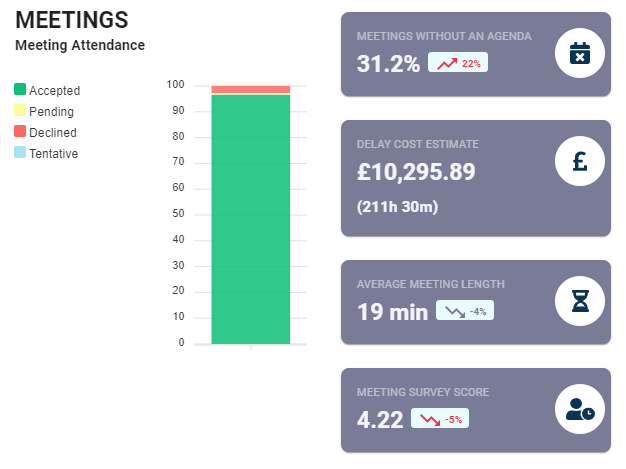
A Harvard Business Review study found that 71% of senior managers viewed meetings as unproductive and inefficient. This statistic highlights the necessity of understanding the purpose behind each meeting to ensure it justifies the time investment.
To determine whether a meeting is necessary, consider the following strategies:
Applying these strategies can ensure that each meeting serves a specific, valuable purpose, contributing positively to the overall productivity and effectiveness of the team. Respecting the time of all participants but also aligning meetings more closely with the organization's strategic goals.
Here's what's particularly problematic about modern meetings. 92% of employees admit to multitasking during them, which isn't a sign of efficiency. It's a clear indicator that these meetings aren't engaging enough to hold people's attention. When only 37% of meetings actually use agendas, we're essentially asking people to participate in unstructured discussions and somehow produce valuable outcomes.
The University of Nebraska-Lincoln found that meetings with pre-distributed agendas are 13% shorter, yet most organizations skip this basic step. Meanwhile, 35% of meeting invites are sent with less than 24 hours' notice, ensuring that attendees arrive unprepared and unfocused. We're not just wasting time. We're actively conditioning our teams to be less engaged and less productive.
Avoid common preparation mistakes and do this instead:
Pre-meeting preparation, particularly the creation and distribution of an agenda, plays a key role in ensuring the efficiency of meetings. By investing time in these preparatory steps, organizations can significantly enhance the productivity of their meetings, making them more focused, engaging, and effective.
Effective time management is crucial for maintaining the productivity and focus of meetings. Keeping meetings within their scheduled time frames respects the time of all participants and ensures that discussions remain purposeful and on-topic.

Want discussions that actually drive results? Try these for once:
Apply above steps consistently, and you'll have meetings that work, meetings are productive, efficient, and valuable. Managing meeting time effectively not only improves the outcomes of the meetings themselves but also contributes to a more respectful and productive culture.
Facilitating productive discussions during meetings is essential for ensuring that the time spent is valuable and goal-oriented. Effective facilitation involves steering conversations to stay on-topic and ensuring that all discussions contribute meaningfully to the meeting’s objectives.
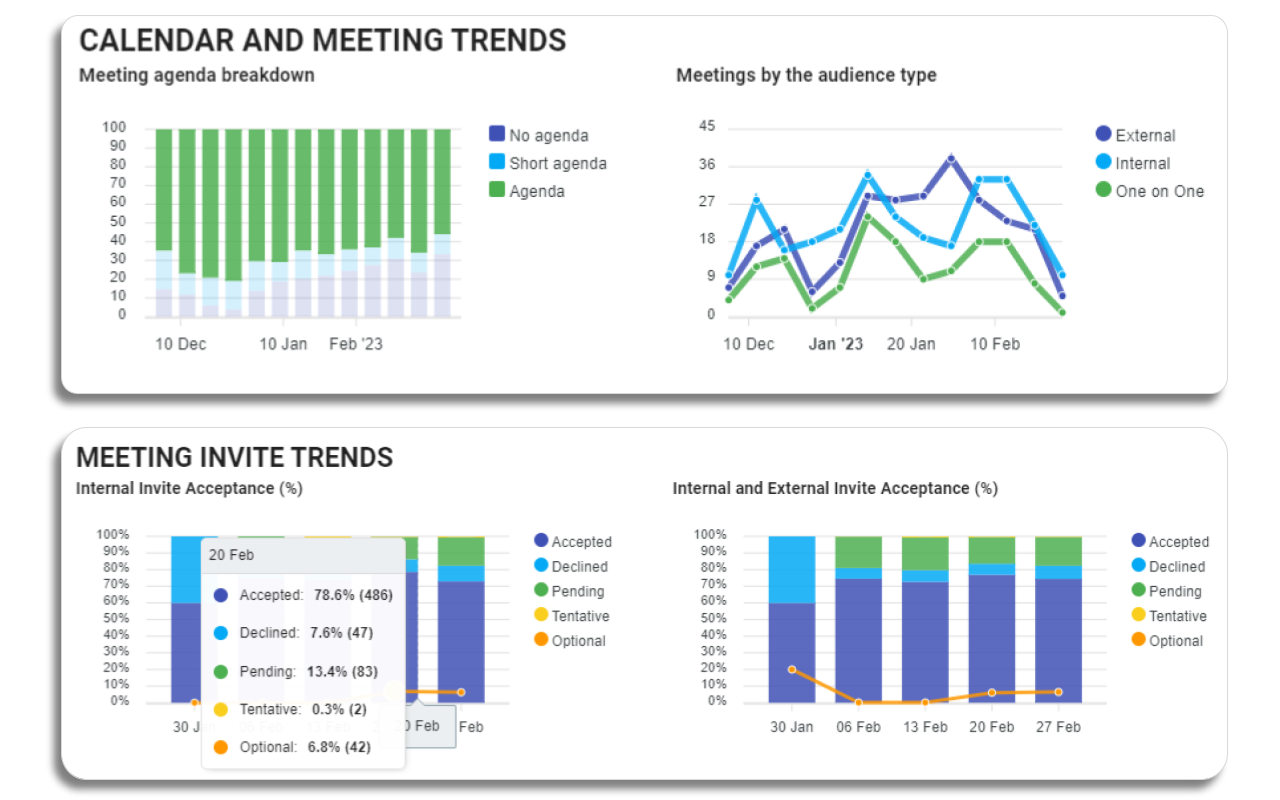
Here are methods to encourage productive discussions and the importance of active facilitation:
Active facilitation and the use of these methods can significantly enhance the productivity of discussions in meetings. By guiding conversations effectively and ensuring that all discussions are purposeful, meetings can become more dynamic and engaging, leading to better outcomes and decision-making.
The statistics on focus time reveal another trend that should trouble organizations serious about productivity. Focus efficiency has dropped to 62% while focus time has decreased by 8% as our calendars became increasingly fragmented. Research by University of California, Irvine shows that it takes 23 minutes to regain full focus after each interruption, reducing overall productivity by up to 40%.
When you consider that the average productive session has decreased to just 24 minutes, the math becomes clear. We're giving people just enough time to begin deep thinking before pulling them into another discussion. Only 19% of managers track progress toward actual KPIs, yet meetings to discuss progress consume significant calendar time. We're optimizing for activity instead of outcomes.

By implementing these principles, organizations not only make meetings more efficient but also significantly enhance the overall productivity and creative capacity of their workforce. This approach recognizes that while collaborative meetings are important, they must be carefully balanced with dedicated time for deep, focused work.
Effective post-meeting follow-up is crucial to ensure that the discussions and decisions made during a meeting translate into action and results. Proper follow-up practices solidify the meeting’s effectiveness and maintain momentum on the tasks at hand.
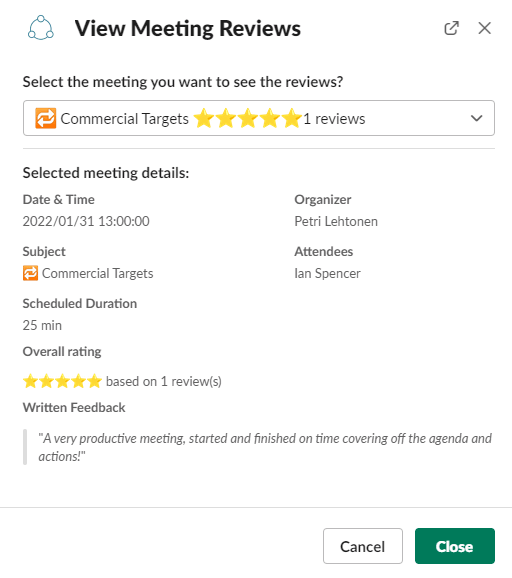
Here's a great list to remind you about the tasks at the meeting follow up:
Effective post-meeting follow-up is about creating a system that ensures these tasks are completed and contributes to the organization's objectives. By adhering to these best practices, meetings can be transformed from mere discussions to catalysts for action and progress.
Let's be realistic about technology's role in meeting optimization. Most organizations are using sophisticated software to facilitate inefficient processes. AI tool adoption is trending upward, with 90% of workers saying AI helps them save time and 85% reporting it helps them focus on critical tasks, yet AI users show consistently longer workdays and 27% less focus time. We have strong doubts about the promised nirvana.
The issue isn't the technology. It's that we're using advanced tools to automate poor processes instead of addressing the underlying meeting culture. Flowtrace's meeting analytics platform reveal that organizations can track meeting patterns extensively while continuing to schedule ineffective sessions. The average business measures meeting costs, tracks engagement, and generates detailed reports about their dysfunction, but only 31% of companies are investing in developing workers' skills to actually change behaviors. We're becoming expert at measuring problems without solving them.
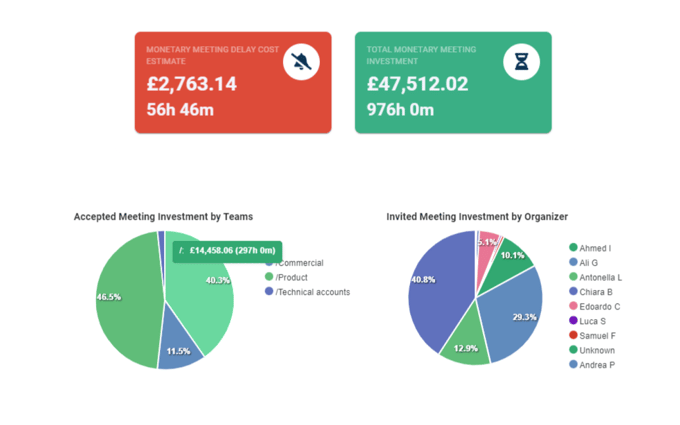
Flowtrace's analytical capabilities provide invaluable insights into meeting patterns within an organization. By evaluating data such as meeting frequency, duration, and participant engagement, helps identify areas where meetings can be optimized. This analysis aids in reducing over-scheduling and ensures meetings are purposeful and aligned with the organization's goals.
Additionally, Flowtrace enhances the planning phase of meetings. Offering a comprehensive view of how meetings are distributed across teams, assists in identifying the optimal times for collaboration, thus avoiding interruptions to periods designated for deep, focused work. This careful scheduling respects the balance between collaborative needs and individual productivity.
Post-meeting, Flowtrace’s features support the follow-up process. Providing insights on the outcomes and participant feedback helps in refining meeting strategies over time. This continuous improvement cycle ensures that meetings remain efficient and contribute positively to the organization's broader objectives.
We don't stop to just plain meeting data insights. We provide tools to transform the way your meetings take place - one invite at a time.
Here's an example how we guard your company's meeting invites right there where the time waste is being incurred. We add a second worth of friction for organizer to think the meeting they invite is actually worth the time, and money.
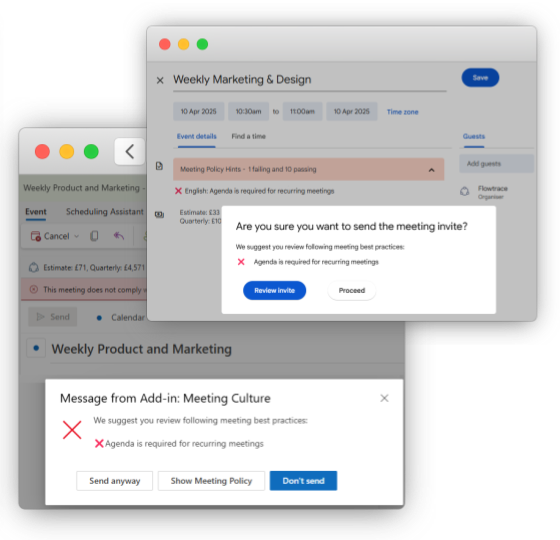
You can delve into deeper from our Meeting Cost for Google Calendar, or Meeting Cost for Outlook product pages.
It's time to acknowledge that we're watching talented people spend their days in meetings, discussing action items that should have been emails, while their meaningful work accumulates. The data is comprehensive, the solutions are validated, and the cost of maintaining the status quo is measured in both financial loss and employee satisfaction. 72% of professionals say clear objectives are key to effective meetings, yet we continue attending agenda-free discussions.
The average workday has become 36 minutes shorter, but 2% more productive. That's evidence that eliminating waste creates real value. It's time to stop accepting meeting dysfunction as inevitable and start requiring that every gathering justify its place on the calendar. Your team's creativity, your company's competitive position, and your employees' engagement depend on this shift. The question isn't whether you can afford to optimize your meetings. It's whether you can afford to continue the current approach.
Should meetings have an agenda? Learn how to implement effective agenda-driven meeting practices in your organization.
Understand meeting invite etiquette tips and learn how clear objectives, detailed agendas, and proper scheduling can transform your meetings into...
Improve your meeting culture with this comprehensive guide to enhance efficiency, reduce waste, and foster better communication in your company...